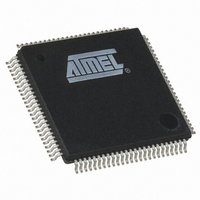AT91SAM7A3-AU Atmel, AT91SAM7A3-AU Datasheet - Page 184

AT91SAM7A3-AU
Manufacturer Part Number
AT91SAM7A3-AU
Description
IC ARM7 MCU FLASH 256K 100LQFP
Manufacturer
Atmel
Series
AT91SAMr
Specifications of AT91SAM7A3-AU
Core Processor
ARM7
Core Size
16/32-Bit
Speed
60MHz
Connectivity
CAN, I²C, MMC, SPI, SSC, UART/USART
Peripherals
POR, PWM, WDT
Number Of I /o
62
Program Memory Size
256KB (256K x 8)
Program Memory Type
FLASH
Ram Size
32K x 8
Voltage - Supply (vcc/vdd)
1.65 V ~ 1.95 V
Data Converters
A/D 8x10b
Oscillator Type
Internal
Operating Temperature
-40°C ~ 85°C
Package / Case
100-LQFP
Controller Family/series
AT91SAM7xx
No. Of I/o's
62
Ram Memory Size
32KB
Cpu Speed
60MHz
No. Of Timers
3
Rohs Compliant
Yes
Package
100LQFP
Device Core
ARM7TDMI
Family Name
91S
Maximum Speed
60 MHz
Operating Supply Voltage
3.3 V
Data Bus Width
32 Bit
Number Of Programmable I/os
62
Interface Type
CAN/SPI/I2S/TWI/USART/USB
On-chip Adc
2(8-chx10-bit)
Number Of Timers
3
Processor Series
AT91SAMx
Core
ARM7TDMI
Data Ram Size
32 KB
Maximum Clock Frequency
60 MHz
Maximum Operating Temperature
+ 85 C
Mounting Style
SMD/SMT
3rd Party Development Tools
JTRACE-ARM-2M, MDK-ARM, RL-ARM, ULINK2
Development Tools By Supplier
AT91SAM-ICE, AT91-ISP, AT91SAM7A3-EK
Minimum Operating Temperature
- 40 C
Cpu Family
91S
Device Core Size
32b
Frequency (max)
60MHz
Total Internal Ram Size
32KB
# I/os (max)
62
Number Of Timers - General Purpose
3
Operating Supply Voltage (typ)
3.3V
Operating Supply Voltage (max)
3.6V
Operating Supply Voltage (min)
3V
Instruction Set Architecture
RISC
Operating Temp Range
-40C to 85C
Operating Temperature Classification
Industrial
Mounting
Surface Mount
Pin Count
100
Package Type
LQFP
For Use With
AT91SAM-ICE - EMULATOR FOR AT91 ARM7/ARM9AT91SAM7A3-EK - KIT EVAL FOR AT91SAM7A3
Lead Free Status / RoHS Status
Lead free / RoHS Compliant
Eeprom Size
-
Lead Free Status / Rohs Status
Details
Available stocks
Company
Part Number
Manufacturer
Quantity
Price
Company:
Part Number:
AT91SAM7A3-AU
Manufacturer:
MXIC
Quantity:
1 001
Company:
Part Number:
AT91SAM7A3-AU
Manufacturer:
Atmel
Quantity:
730
- Current page: 184 of 594
- Download datasheet (7Mb)
25.4.2
25.4.2.1
25.4.2.2
6042E–ATARM–14-Dec-06
Receiver
Receiver Reset, Enable and Disable
Start Detection and Data Sampling
Figure 25-3. Baud Rate Generator
After device reset, the Debug Unit receiver is disabled and must be enabled before being
used. The receiver can be enabled by writing the control register DBGU_CR with the bit RXEN
at 1. At this command, the receiver starts looking for a start bit.
The programmer can disable the receiver by writing DBGU_CR with the bit RXDIS at 1. If the
receiver is waiting for a start bit, it is immediately stopped. However, if the receiver has already
detected a start bit and is receiving the data, it waits for the stop bit before actually stopping its
operation.
The programmer can also put the receiver in its reset state by writing DBGU_CR with the bit
RSTRX at 1. In doing so, the receiver immediately stops its current operations and is disabled,
whatever its current state. If RSTRX is applied when data is being processed, this data is lost.
The Debug Unit only supports asynchronous operations, and this affects only its receiver. The
Debug Unit receiver detects the start of a received character by sampling the DRXD signal
until it detects a valid start bit. A low level (space) on DRXD is interpreted as a valid start bit if
it is detected for more than 7 cycles of the sampling clock, which is 16 times the baud rate.
Hence, a space that is longer than 7/16 of the bit period is detected as a valid start bit. A space
which is 7/16 of a bit period or shorter is ignored and the receiver continues to wait for a valid
start bit.
When a valid start bit has been detected, the receiver samples the DRXD at the theoretical
midpoint of each bit. It is assumed that each bit lasts 16 cycles of the sampling clock (1-bit
period) so the bit sampling point is eight cycles (0.5-bit period) after the start of the bit. The first
sampling point is therefore 24 cycles (1.5-bit periods) after the falling edge of the start bit was
detected.
Each subsequent bit is sampled 16 cycles (1-bit period) after the previous one.
MCK
16-bit Counter
CD
OUT
0
AT91SAM7A3 Preliminary
CD
>1
1
0
Divide
by 16
Baud Rate
Receiver
Sampling Clock
Clock
184
Related parts for AT91SAM7A3-AU
Image
Part Number
Description
Manufacturer
Datasheet
Request
R

Part Number:
Description:
MCU ARM9 64K SRAM 144-LFBGA
Manufacturer:
Atmel
Datasheet:

Part Number:
Description:
IC ARM9 MPU 217-LFBGA
Manufacturer:
Atmel
Datasheet:

Part Number:
Description:
MCU ARM9 ULTRA LOW PWR 217-LFBGA
Manufacturer:
Atmel
Datasheet:

Part Number:
Description:
MCU ARM9 324-TFBGA
Manufacturer:
Atmel
Datasheet:

Part Number:
Description:
IC MCU ARM9 SAMPLING 217CBGA
Manufacturer:
Atmel
Datasheet:

Part Number:
Description:
IC ARM9 MCU 217-LFBGA
Manufacturer:
Atmel
Datasheet:

Part Number:
Description:
IC ARM9 MCU 208-PQFP
Manufacturer:
Atmel
Datasheet:

Part Number:
Description:
MCU ARM 512K HS FLASH 100-LQFP
Manufacturer:
Atmel
Datasheet:

Part Number:
Description:
MCU ARM 512K HS FLASH 100-TFBGA
Manufacturer:
Atmel
Datasheet:

Part Number:
Description:
IC ARM9 MCU 200 MHZ 324-TFBGA
Manufacturer:
Atmel
Datasheet:

Part Number:
Description:
IC ARM MCU 16BIT 128K 256BGA
Manufacturer:
Atmel
Datasheet:

Part Number:
Description:
IC ARM7 MCU 32BIT 128K 64LQFP
Manufacturer:
Atmel
Datasheet:

Part Number:
Description:
IC ARM7 MCU FLASH 256K 128-LQFP
Manufacturer:
Atmel
Datasheet:

Part Number:
Description:
IC ARM7 MCU FLASH 512K 128-LQFP
Manufacturer:
Atmel
Datasheet:

Part Number:
Description:
IC ARM9 MPU 217-LFBGA
Manufacturer:
Atmel
Datasheet:











